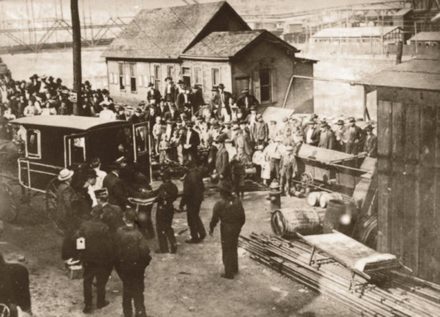
Rolling Mill Mine Disaster
July 10, 1902From the Johnstown Tribune-Democrat, 10/28/2017
Story by Ronald Fisher
The first large-scale mining began in the Johnstown area when the Cambria Iron Co. opened the Rolling Mill Mine in 1856.
The Rolling Mill Mine, located off Route 56 on the hillside next to the Johnstown Inclined Plane, covered the largest area in the nation worked by a single opening. In 1922, it covered 10 square miles and the farthest working face was 5 miles from the entrance.
On July 10, 1902, approximately 11 a.m., a powerful gas explosion occurred in the Klondike section of the mine, ultimately claiming the lives of 112 miners.
“This devastated the immigrant communities,” said Johnstown Area Heritage Association President and CEO Richard Burkert.
“A lot of the immigrants were young and from Eastern and Central European countries,” he said. “There were 40 Polish miners and many Slovak immigrants that lost their lives in the explosion.”
During the turn of the 20th century, coal was the dominant power source in the United States, which led to the creation of many jobs in the area.
The demand for workers attracted many unskilled laborers to the area.
Most of the immigrants did not plan to remain in the area; however, two-thirds of them eventually stayed, according to Burkert.
“Single men, living in temporary arrangements,” Burkert said.
Because of the large number of temporary residents working in the mine, it took longer than usual to identify many of the bodies discovered.
In the July 11, 1902, edition of the Johnstown Tribune, an article titled “A ‘Tribune’ Man In The Mine” recalls the account of an unnamed reporter’s two-hour journey through the Rolling Mill Mine just a day after the disaster.
The reporter, with a miner’s lamp in hand, made his way unnoticed down the steps leading into the shaft.
The article reads: “From the womb of the mine came up intermittent blasts of chilling air which smelled of the night and reminded one of bats hanging down from damp places in musty chambers and of rats gazing stealthily at one from behind rickety doors.”
Further into the story, it reads: “At one place five or six miners had been stationed, with orders to allow no one to enter through the doors before which the men stood guard, for beyond these doors, lurked a gripping, subtle death which can kill by filling the lungs with a gas as deadly as that which did Mt. Pelee’s bidding.”
The explosion was attributed to what miners refer to as “firedamp,” a methane gas mixture.
While only seven of the miners were killed during the explosion, the rest were killed by an asphyxiating gas called “afterdamp” that spread throughout the mine as they fled to the only other exit, the Millcreek Portal, located several miles away.
The mine was reopened on July 14, 1902, but the disaster devastated the immigrant community in Johnstown, which provoked calls for investigations and greater safety measures. An inquest discovered that the disaster was caused by an unnamed miner who had used an open flame lamp in a mine section known to be dangerously gaseous.
The “Rolling Mill Mine Disaster” still ranks as one of the most deadly accidents in the history of mining in the United States.
Photo from the Johnstown Area Heritage Association archive
